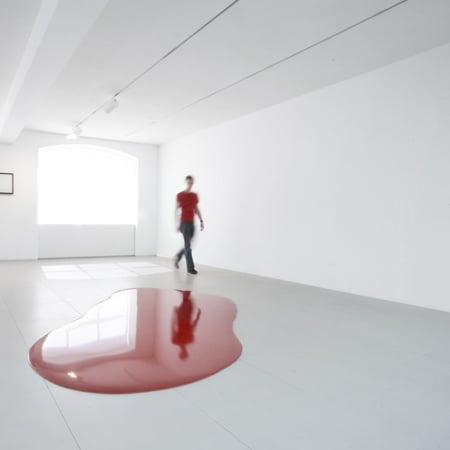
Design High at Louise Blouin Foundation
Design High, an exhibition of design art, opened at Louise Blouin Foundation in London on Thursday, featuring work by Atelier van Lieshout, Joris Laarman, Robert Stadler and others.
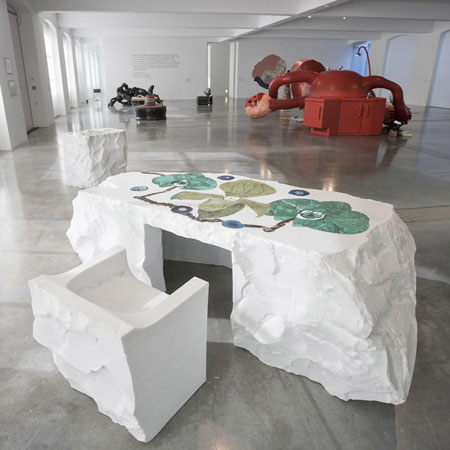
Curated by Natalie Kovacs, the exhibition is in partnership with Carpenters Workshop Gallery. Top image: Farbuß/colour-pouring by Rainer Splitt, 2009. Above (foreground): Desk and Lake chair by Marc Quinn, 2008.
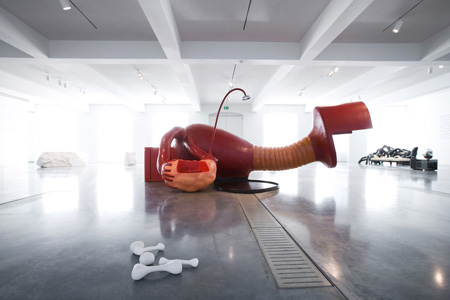
Above: Wombhouse by Atelier van Lieshout.
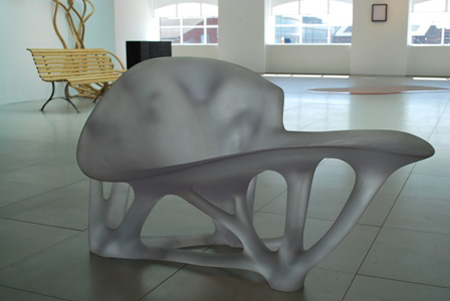
Above: Bone Chaise by Joris Laarman, 2006.
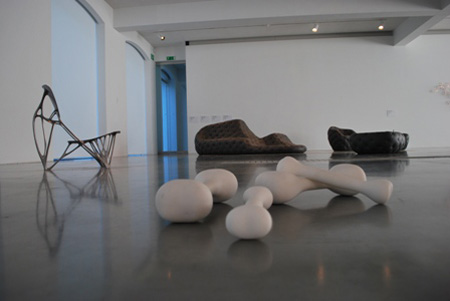
Above: Bone Chair by Joris Laarman (left); Foreveryoung by Robert Stadler (foreground); various pieces by Robert Stadler (background).
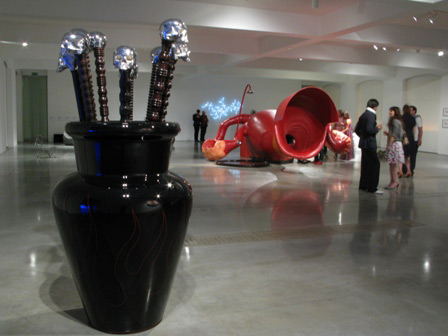
Above: BJ+SSn°3802071 by Lionel Scoccimarro
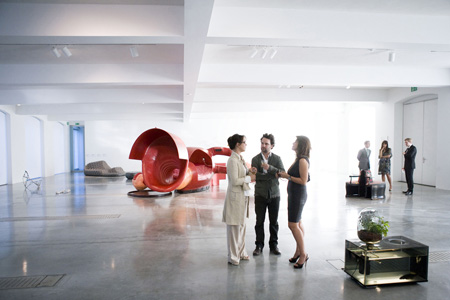
Here's some text about the exhibition plus biographies of the designers involved and an essay by curator Natalie Kovacs:
--
Design High
25 June – 30 August 2009
A group exhibition of design art by ATELIER VAN LIESHOUT, DRIFT, INGRID DONAT, JORIS LAARMAN, LIONEL SCOCCIMARO, MARC QUINN, MATHIEU LEHANEUR, PABLO REINOSO, RAINER SPLITT, rANDOM INTERNATIONAL, ROBERT STADLER, SEBASTIAN BRAJKOVIC, THIERRY DREYFUS, VINCENT DUBOURG and WENDELL CASTLE.
The Louise Blouin Foundation is delighted to announce its partnership with Carpenters Workshop Gallery, one of the world’s leading design art galleries, in a collaborative exhibition that will feature several of the most important and innovative artists in the field of contemporary design art.
Design High will specifically address the tensions that exist between craft and fine art among some of the most innovative established and emerging artists in the field, including Marc Quinn, Pablo Reinoso, Thierry Dreyfus, Vincent Dubourg and Sebastian Brajkovic. Working in an idiom that does not preclude a purpose beyond formalist or subjective aims, design art is both celebrated and dismissed for embracing some form of functionality or usefulness.
Design High will be on view at the Louise Blouin Foundation, 3 Olaf Street, Holland Park. An opening reception will be held on Wednesday, 24 June from 6.30 to 11.00 pm.
Design High will focus specifically on the fine, and perhaps illusory, line between art and craft. In addition to pieces by some of the most established names in design art like Marc Quinn and Thierry Dreyfus, the show will feature up-and-coming proponents of the genre that blur and manipulate the line between formalism and functionality. Sebastian Brajkovic, a celebrated young artist whose works subvert the recognizable forms of historical styles of furniture into surreal and dysfunctional sculpture, will be represented, along with Vincent Dubourg, another artist who uses traditional and found objects, weaving into them the most elemental forms from nature: branches of trees blend with cases, bureaus, chairs, or even a staircase, giving both Nature and the objects a new identity and a new functionality.
Other artists like Ingrid Donat work with more traditionally identifiable objects, but Donat casts these in bronze to create pieces of sculptural monumentality. Still others, like Marc Quinn revel in the tactile qualities of glacially-smooth Carrara marble, glass and metal, creating ostensibly functional objects that simultaneously feel far removed from the practical and the everyday.
“Design art has fuelled the debate between culture and commerce for years. But the mission of great design is to build a better world: a more inspiring, comfortable, logical or pleasurable world” says Louise Blouin, Founder and Chairman, Louise Blouin Foundation. “In this way, design art is the very essence of culture; it touches us and transforms us through objects, architecture and urban planning. Design art may have a function or even a prosaic usefulness but simultaneously can cause euphoria and remind us of our limitless collective potential “ she adds.
The vast scale and ‘blank-canvas’ quality of the Louise Blouin Foundation’s galleries serve as a springboard for the artists’ creative processes. Several works exhibited in Design High have been created in direct response to the monumental scale and dramatic and varied light of the gallery spaces at the Foundation. Design High will also complement design offerings at Tate Modern and the Victoria and Albert Museum happening concurrently this summer.
Design High will be complimented by a series of educational events which form part of the ongoing Louise Blouin Foundation Education, Science and Creativity Programme. Panel discussions, lectures and workshops will explore the ties and tensions that exist between form and function in design art. Workshops will be led by the participating artists. Leading academics, curators and critics will deliver talks and discussions which explore themes related to current views on design as an art form, the market for design and the future of functional art in an international market.
About the Artists
ATELIER VAN LIESHOUT
AVL’s creative team produces practical, uncomplicated and substantial works of art which permit an element of what they describe as the ‘absence of design’. These new works exploit common industrial materials such as galvanized steel tubing used in scaffold construction and sheets of unfinished plywood combined with their trademark preference for brightly coloured polyester. AVL designs furniture to satisfy a self sufficient and independent lifestyle in the same spirit of the company’s own ideological tenets realised in their miniature models of ‘Slave Cities’ fashioned into lamps, chairs and tables.
DRIFT
Design studio DRIFT was founded by Ralph Nauta (1978) and Lonneke Gordijn (1980), both graduates from Design Academy Eindhoven in the Netherlands (2005). With a shared passion for watching human behaviour, DRIFT designs products, projects and concepts for interior and public spaces. Nauta is an expert in many crafts, materials and production techniques. Gordijn has a fantastic sense for shape and conceptualisation. Together they combine knowledge and intuition, nature and science fiction, ideology and reality.
INGRID DONAT
Paris-born Ingrid Donat learned the art of sculpture from design to construction, casting, engraving and painting from Sylvia Berndt, the companion of Andre Arbus. For the past twenty years Donat has been creating a body of work that she only began to exhibit publicly in 1998. Donat engraves bronzes, painted upholstery and treated wood. The artist is inspired by the bold colours and forms of tribal art, the elegance and simplicity of Art Deco and the organic and natural motifs of Art Nouveau.
JORIS LAARMAN
Joris Laarman graduated from the renowned Design Academy Eindhoven in 2003, where he gained first notoriety with his functional rococo radiator heatwave. He has been a guest teacher at European universities like the Architectural Association London, Rietveld academy Amsterdam and the Design Academy Eindhoven. One of the most innovative Dutch designers today, Laarman created his 'Bone' series using an algorithm originally developed by a scientist to replicate the way bones grow.
LIONEL SCOCCIMARO
Like much current art, that of Lionel Scoccimaro generally displays a very smooth and accomplished technique, resulting from the use of industrial resins, lacquers and processes. This type of treatment, in which the artist’s ‘formal psychology’ appears at first sight to have left few traces, aims at a certain efficacy that suggests immediate comprehension. This legible lexicon of symbols belies the complexity of Scoccimaro’s multi-layered messages.
MARC QUINN
Marc Quinn’s wide-ranging oeuvre displays a preoccupation with the mutability of the body and the dualisms that define human life: spiritual and physical, surface and depth, cerebral and sexual. Using an uncompromising array of materials, from ice and blood to glass, marble or lead, Quinn develops these paradoxes into experimental, conceptual works of art.
MATHIEU LEHANNEUR
Lehanneur graduated from the ENSCI Workshops in 2001. He has a passion for early interactions between the body and its environment, living systems and the scientific world. Mixing into these creations of technology and natural elements (plants, algae ...), he develops projects and exploratory design in the pharmaceutical, biological or astrophysics.
PABLO REINOSO
Pablo Reinoso has practiced the art of sculpture since he was a teenager. A French-Argentine artist and designer, born in Buenos Aires, Argentina in 1955, Reinoso has lived and worked in Paris since 1979. For many years Reinoso has worked with wood, slate, marble, brass, and steel, adapting his creations to a variety of materials.
RAINER SPLITT
Rainer Split studied at the University of fine arts Brunswick, the Ecole des Beaux-Arts in Nimes and the School of Visual Arts in New York. Today he lives and works in Berlin. He is well known for his dipped boards especially for his colour casts in resin and polyurethane. He received for his work some awards, including in 2003 the prestigious scholarship of German Academy Rome Villa Massimo.
rANDOM INTERNATIONAL
rAndom International is a London-based collective set up in 2002 by Stuart Wood, Flo Ortkrass and Hannes Koch. Their work explores the conflict between reinterpreting the ‘cold’ nature of digital and the often hands-on approach of analogue. To achieve this rANDON INTERNATIONAL starts by searching and exploring the relationship between science, art and design. Most of the work is interactive, fuelled by an intense curiosity applied to experimental processes.
ROBERT STADLER
Viennese-born Stadler studied design in Milan and then at ENSCI/Les Ateliers in Paris. Stadler’s work often attempts to scramble the usual categories of art and design by questioning the status of the object as work of art or product, addressing qualities of preciousness and lowliness, elegance and vulgarity and seriousness and absurdity.
SEBASTIAN BRAJKOVIC
After completing a course in cabinet-making at school, Brajkovic applied to both the Rietveld Academie and Design Academy Eindhoven, being torn between a fine arts or design education. He eventually chose the Design Academy with a view to make art that wanted to be design and design that was art. Brajkovic studied under Gijs Bakker, Hella Jongerius and Jurgen Bey. He also continued his studies in philosophy at Utrecht University and carried out an invaluable internship at Jurgen Bey’s studio. In June 2006 Brajkovic graduated with the "Lathe Chairs" and "Home Grown" projects and has already made a name for himself as a brilliant young design artist.
THIERRY DREYFUS
Dreyfus is one of the leading lights of design art. He first came to prominence as a lighting designer for the stage, working at the Strasbourg Opera in the 1980s. His career quickly expanded into fashion show lighting for some of the greatest fashion houses, including Yves Saint-Laurent, Christian Dior and Helmut Lang. Since 1989 Dreyfus has had an ongoing collaboration with the designer Ann Demeulemeester. Alongside his work for the catwalk and the opera house, Dreyfus has created a spectacular body of lighting projects, from the domestic to monumental public projects. For Design High, the dramatic scale of the Louise Blouin Foundation’s entrance gallery has served as the inspiration for a site-specific light installation.
VINCENT DUBOURG
The French designer, Vincent Dubourg, works in Paris and the small town of Creuse, where his atelier is located. Dubourg's latest work challenges traditional notions of contemporary furniture design by embracing an openness towards found and natural materials. His unique pieces evoke a sense of the familiar and deliberately defy categorization as design or art. Dubourg describes his pieces as a fusion of furniture, architecture and sculpture, where he strikes a careful balance between the practical and the beautiful. Dubourg uses traditional furniture making techniques such as glass blowing, wood-bending, and metal casting as a means of transforming simple materials and found objects. His distinct style is at once nostalgic and avant-garde.
WENDELL CASTLE
Castle’s work is recognised for its wry wit and uniquely sculptural use of materials, including his signatures: stack-laminated wood and fibreglass. His new body of work explores volume in fibreglass and stainless steel while using a vibrant and unexpected playful spectrum of colour and iridescent texture. Castle has exhibited at over 40 museums across the world.
Practical Information
Louise Blouin Foundation
3 Olaf Street London W11 4BE
www.ltbfoundation.org
+44 (0)20 7985 9600
[email protected]
ADMISSION IS FREE
Gallery Hours
Tuesday - Friday 10am - 6pm
Thursday 10am - 9pm
Saturday midday - 6pm
Café open Monday - Friday
Getting to the Foundation
Tube stations: Latimer Road/Holland Park/
Shepherd’s Bush
--
Design High curated by Natalie Kovacs /Carpenter’s Workshop Gallery at Louise Blouin Foundation
A “design high” is a metaphysical experience upon an encounter with great sculptural art, where form and function meet to transcend the quotidien. Elevation, illumination and elucidation create the necessary conditions this occurrence.
Where sculpture, painting, architecture and installation merge into one another, existing powers of association are dissolved through a design dialogue. Design high is a baroque sensation; where both geometric and organic forms are reduced and combined, to result in contemplative reflection.
This exhibition examines the concept of ‘composition’; of the body, of architecture, of nature, forcing us to confront the artist’s eternal question of how, where and why we began. Design High refers to the altered states within our own evolution.
Sculpture is a confrontation: it physically demands that we reconsider our relationship to the planet and our finite position within it. Design High frees the mind from bonds of definition developed and enforced through centuries. Design need not be décor. At its most far-reaching, its forms are life forms.
One must remember that all arts once had functional aims, rather than decorative or depictive ones. Cave paintings were created for enchantment, being ways of conjuring up and securing food. The sculptures, reliefs and two-dimensional works in Ancient Egypt, China or Meso-America were not perceived as “art.” Icons of the Dark Ages were designs for living. They weren’t perceived as “pictures” but as raw spiritual material, as alive as a body.
The separation between Art and Design soon became clear on the cultural map. A painting was a painting. A table, even the Round Table, was just a thing one sat around. At times, the two streams have converged, as with the Arts & Crafts Movement, the Aesthetic Movement, the Bauhaus and in the UK we had the strivings of Sir Herbert Read. In the 1960s it would be the norm for anybody interested in the arts to also have an interest in design, perhaps indeed to own a Mies van de Rohe Barcelona chair, an Eames chair or an Anglepoise lamp. This rapprochement unravelled. In the 70s and for much of the 80s, for most, Design was a high culture “No Go” area.
That has changed utterly. These works microcosmically encapsulate our world, our planet, our society, while simultaneously forcing our minds to think outside such constrictions and conditions, to connect with the universal and unknowable.
Society adheres to prescribed day-to-day patterns of behaviour. This exhibition investigates the organic versus the man-made. Operating outside the realm of reality, within the realm of art, the work questions both habitual practises that we perform by rote and expands our perceptions of how we survive, reflecting human needs such as food, shelter, production and reproduction.
AVL consider the body as perfect architecture: a divine design, exemplified by the Wombhouse. No line is drawn between design, architecture and art. Categorization and definition become obsolete. In analysing our world through design, we create a lens through which infinitude can be viewed. As a mirror of mortality, the work invites us to reconsider Mother Nature’s blueprint, the physical presence inspiring other-worldly contemplation.
The pieces reflect the planet we live on and our relationship to it. The three basic human needs for survival are represented in both organic and inorganic forms, from AVL’s Wombhouse to the Lehanneur’s Local River, where the combined elements of plants, water and fish create art that not only sustains the spirit, but also the body.
‘A design high offers an epiphany: we can be momentarily certain of a parallel reality beyond the plane of our understanding. Finally, we realize our own actions and our own place within the eternal. In this way, we live and die by design.’ (quote Natalie Kovacs, curator)
Natalie Kovacs, Curator